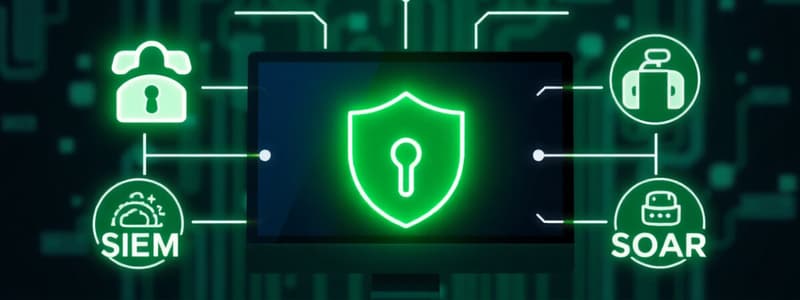Podcast
Questions and Answers
What is a primary advantage of security automation?
What is a primary advantage of security automation?
- Increases manual workloads for security teams.
- Improves efficiency by automating tedious tasks. (correct)
- Reduces the speed of responses to security threats.
- Inhibits proactive approaches to security.
Which component is specifically designed to provide a centralized view of security events and logs?
Which component is specifically designed to provide a centralized view of security events and logs?
- Threat intelligence feeds
- Vulnerability Management
- Security Information and Event Management (SIEM) (correct)
- Endpoint Detection and Response (EDR)
What does SOAR stand for, and what is its primary function?
What does SOAR stand for, and what is its primary function?
- Secure Operations and Automated Response; responding to vulnerabilities.
- Security Orchestration, Automation, and Response; automating responses to incidents. (correct)
- Security Observation and Analytics Response; analyzing threats.
- Security Operations and Analysis Resource; managing security workflows.
Which of the following benefits does security automation NOT provide?
Which of the following benefits does security automation NOT provide?
What is the role of vulnerability scanners in security automation?
What is the role of vulnerability scanners in security automation?
In security automation, what do threat intelligence feeds contribute to?
In security automation, what do threat intelligence feeds contribute to?
How does automation impact the response time to security incidents?
How does automation impact the response time to security incidents?
Which component is focused on detecting and responding to threats on endpoints?
Which component is focused on detecting and responding to threats on endpoints?
What is a primary benefit of security automation related to resource management?
What is a primary benefit of security automation related to resource management?
Which challenge in security automation pertains to the complexity of combining systems?
Which challenge in security automation pertains to the complexity of combining systems?
What is a necessary practice for ensuring the effectiveness of automated security systems?
What is a necessary practice for ensuring the effectiveness of automated security systems?
What future development in security automation is expected to enhance threat detection?
What future development in security automation is expected to enhance threat detection?
Why is managing large volumes of security data a significant challenge?
Why is managing large volumes of security data a significant challenge?
What does the lack of standardization in automation typically lead to?
What does the lack of standardization in automation typically lead to?
Which aspect is vital for maintaining security automation tools?
Which aspect is vital for maintaining security automation tools?
What is an important focus for the future of security automation?
What is an important focus for the future of security automation?
What is a consequence of automated systems generating false positives?
What is a consequence of automated systems generating false positives?
What is a crucial step recommended before deploying security automation solutions?
What is a crucial step recommended before deploying security automation solutions?
Flashcards
What is security automation?
What is security automation?
Security automation uses software and tools to automate tasks, processes, and workflows in security.
What does SIEM stand for and what does it do?
What does SIEM stand for and what does it do?
SIEM systems gather, analyze, and connect security logs and events to spot potential threats.
What is SOAR and how does it work?
What is SOAR and how does it work?
SOAR automates responses to security incidents, allowing faster and more effective remediation.
What is vulnerability management?
What is vulnerability management?
Signup and view all the flashcards
What does EDR stand for and how does it work?
What does EDR stand for and how does it work?
Signup and view all the flashcards
How does security automation improve efficiency?
How does security automation improve efficiency?
Signup and view all the flashcards
How does security automation improve response time?
How does security automation improve response time?
Signup and view all the flashcards
How does security automation enhance security posture?
How does security automation enhance security posture?
Signup and view all the flashcards
Increased compliance
Increased compliance
Signup and view all the flashcards
Proactive Security
Proactive Security
Signup and view all the flashcards
Scalability
Scalability
Signup and view all the flashcards
Better resource allocation
Better resource allocation
Signup and view all the flashcards
Integration Complexity
Integration Complexity
Signup and view all the flashcards
Data Management
Data Management
Signup and view all the flashcards
False Positives
False Positives
Signup and view all the flashcards
Security of automation tools
Security of automation tools
Signup and view all the flashcards
Maintaining and updating tools and systems
Maintaining and updating tools and systems
Signup and view all the flashcards
Skill Gap
Skill Gap
Signup and view all the flashcards
Study Notes
Introduction to Security Automation
- Security automation automates security tasks, processes, and workflows using software and tools.
- This improves efficiency by reducing manual workload, allowing teams to focus on strategic initiatives.
- Automation quickly responds to threats and vulnerabilities, minimizing downtime and damage.
- Broadening coverage and detection are essential to maintain a strong security posture.
- Automation enables proactive security measures.
Key Components of Security Automation
- SIEM (Security Information and Event Management): Collects, analyzes, and correlates security logs/events to detect threats.
- SOAR (Security Orchestration, Automation, and Response): Automates security incident responses, often integrating with SIEM for quick remediation.
- Vulnerability Management: Automatically scans systems to identify vulnerabilities, prioritizing remediation efforts.
- EDR (Endpoint Detection and Response): Detects and responds to threats on endpoints (desktops, laptops, mobile devices).
- Vulnerability scanners: Identify security weaknesses in applications and systems, enabling proactive responses.
- Incident response platforms: Automate incident handling for faster, more consistent responses to breaches.
- Threat intelligence feeds: Enhance automated detection/response by providing information about current threats/vulnerabilities.
Benefits of Security Automation
- Improved efficiency/decreased workload: Automation reduces manual tasks, allowing for strategic focus.
- Faster threat response: Automated responses are quicker than manual processes, limiting incident impact and downtime.
- Enhanced security posture: Increased coverage/detection capabilities strengthen an organization's security posture.
- Reduced human error: Automation eliminates errors inherent in manual tasks.
- Increased compliance: Automation aids in meeting security regulations and compliance standards.
- Proactive security: Automation enables continuous proactive monitoring of potential threats.
- Scalability: Adapts to organizational growth.
- Better resource allocation: Allows for better prioritization of security tasks/resources.
Challenges of Security Automation
- Integration complexity: Integrating various security tools/systems can be technically complex and time-consuming.
- Data management: Managing large volumes of security data from various systems requires appropriate infrastructure.
- False positives: Automated systems may generate false alerts, necessitating human review for refinement.
- Security of automation tools: Ensuring the security of automation tools themselves is crucial.
- Maintaining/updating tools/systems: Consistent maintenance/updates are essential for effectiveness.
- Skills gap: Security teams may lack expertise to effectively manage/deploy automation tools.
- Lack of standardization: Issues with compatibility due to a lack of industry standards in automation tools.
- Cost: Implementing comprehensive security automation can be expensive.
Future of Security Automation
- Greater integration with AI/ML for predictive analysis and threat detection.
- Further development of automation/orchestration, including improved automated incident response/remediation.
- Increased adoption of cloud-based security automation for flexibility/scalability.
- Integration with broader enterprise IT systems.
- Emphasis on zero-trust security models integrated with automation.
- Continued improvement in threat detection, response, and recovery.
- Automation is vital for maintaining/strengthening organizational security posture.
Security Automation Best Practices
- Establish clear security objectives: Define specific goals for automation implementations.
- Phased approach: Implement automation in stages based on priorities/feasibility.
- Prioritize existing tool integration: Leverage current tools before integrating new ones.
- Thorough testing/validation: Ensure systems function correctly before deployment.
- Comprehensive training/documentation: Provide personnel with the knowledge to use/maintain systems.
- Performance monitoring/review: Evaluate efficiency/effectiveness for improvements.
- Robust incident response plan: Define procedures for unexpected situations.
- Regular security updates: Ensure all tools/systems are up-to-date for sustained effectiveness.
Studying That Suits You
Use AI to generate personalized quizzes and flashcards to suit your learning preferences.




